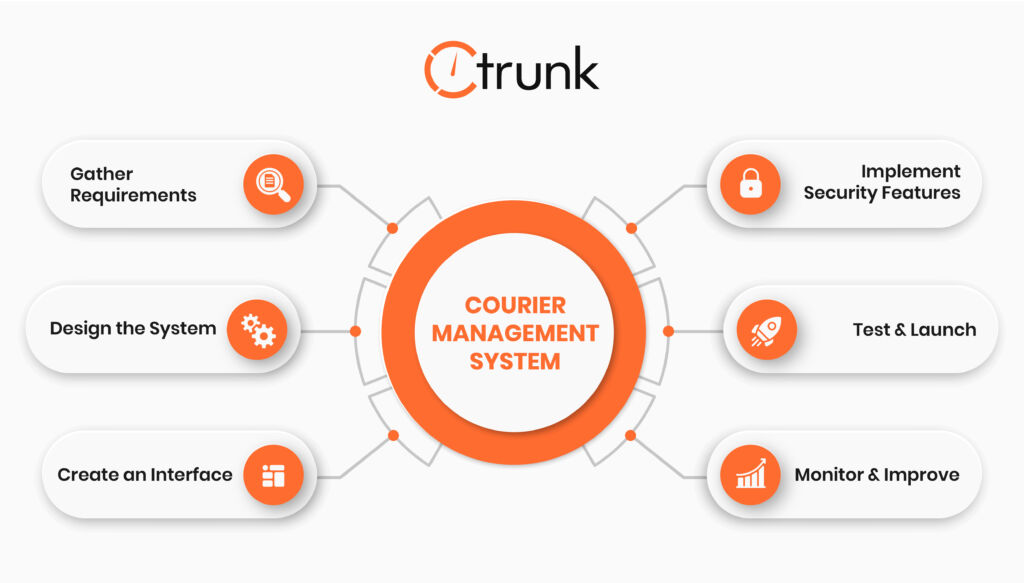Common Types of Courier Services


In today’s fast-paced world, delivery has become an integral part of our lives. Whether it’s a package, a mouth-watering meal, or even a piece of furniture, everything can now be swiftly delivered right to our doorstep, thanks to the sophisticated Courier Management System (CMS).
However, choosing the right CMS for your business is crucial. Making a wrong choice can prove to be costly, as it may lack essential features or fail to help you achieve your business objectives.
In this article, we will guide you on how to develop a highly successful CMS that not only incorporates all your potential requirements but also helps you reach your desired goals!

Before diving into the development process, it’s vital to thoroughly understand the requirements of your courier management system. What types of couriers will be used? What tracking capabilities are essential for your system? By identifying these requirements, you can lay a solid foundation for your CMS.
Once you have gathered your requirements, it’s time to design your CMS. Create a comprehensive diagram that outlines all the components and features of your system. This blueprint will ensure that every aspect is accounted for and that the system works seamlessly in both development and production environments.
Choosing the right technology stack is a critical decision that can impact the performance and scalability of your courier management system. We’ll explore different technologies and frameworks that can be utilized to build a robust and scalable system.
After designing your system, shift your focus to creating a user-friendly interface with the help of shift management software. The interface should be intuitive, allowing users to effortlessly interact with the system. Whether through web or mobile applications or APIs for integration with other systems, the goal is to provide quick access to orders and shipment tracking with minimal effort.
To enhance the functionality of your courier management system, integrating with external systems and services is essential. We will discuss the benefits of integrating with mapping services, payment gateways, and other relevant third-party APIs.
Security is paramount in any software or digital platform. Implement encryption protocols and authentication mechanisms like two-factor authentication (2FA) to ensure data protection from malicious actors. Additionally, user role access controls can limit user permissions, enhancing security within the platform.
Once development is complete and security measures are in place, thorough testing is essential. Test every aspect of your CMS to ensure seamless performance in real-world scenarios. This rigorous testing phase guarantees that everything runs smoothly when customers start using the system regularly.
Launching your CMS is just the beginning. Continuous monitoring of its performance is crucial. Gather customer feedback and leverage usage data from testing phases and analytics platforms like Google Analytics or Mixpanel. Based on this valuable insight, make improvements over time, ensuring an ever-evolving, customer-centric system.
Choose a courier management software that offers straightforward integration and unparalleled flexibility. With the right tools in place, your business can adapt quickly to ongoing operational changes and easily add new features. Stay ahead of predicted transformations and embrace opportunities more readily than ever before.
Invest in delivery management software that offers seamless integration and flexibility. This adaptability allows you to quickly accommodate changes in ongoing operations and effortlessly add new features. Equip your company with the right tools to stay ahead of predicted transformations, embracing opportunities with ease.
Harness the power of advanced reporting and analytics features within your courier management system. Gain valuable insights to optimize customer satisfaction, streamline delivery times, and reduce costs. Informed decision-making leads to a brighter future for your operations.
Thanks to GPS-enabled smartphones, customers can now track their orders in real-time. No more waiting in uncertainty! Push notifications keep them informed at every step of the delivery journey. Your organization benefits too, as live tracking data streamlines operations, providing insights on fleet location, routes, and timings.
Courier services that are tailored to each city, ensuring an optimal delivery experience. By establishing distinct zones and their respective prices, we meet the unique needs of your business in a convenient and affordable manner.
An effective courier delivery management system is a game-changer for any business. With this software, you can effortlessly handle tasks ranging from route planning and optimization to tracking courier performance and scheduling services.
Say goodbye to manual labor! A powerful CMS offers package tracking during deliveries, keeping customers informed at every stage. It’s an invaluable tool that helps businesses stay competitive in today’s market.
Unlock the potential of collaborative integration with cTrunk’s CEP blend platform. Experience unparalleled precision and accuracy in logistics operations through cutting-edge systemized management. Maximize productivity, streamline resources, and optimize every process with minimal onboarding time. Enjoy the user-friendly interface that puts you in control.
Developing a courier management system is a challenging endeavor, but when done correctly, it brings incredible rewards. By following these steps – gathering requirements, designing, creating an interface, implementing security features, testing & launching, and monitoring & improving – you can create a robust platform tailored to your customers’ needs.
Armed with this comprehensive guide, you are now ready to launch the perfect Courier Management System! Looking for a Courier Management System? We’re Here to Help!
Contact us today and let us assist you in realizing your vision of an efficient and customer-centric courier management system. Together, we can make it happen!